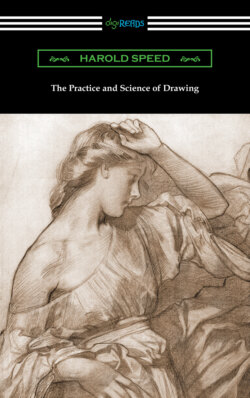Читать книгу The Practice and Science of Drawing - Harold Speed - Страница 26
На сайте Литреса книга снята с продажи.
IV. LINE DRAWING
ОглавлениеMost of the earliest forms of drawing known to us in history, like those of the child we were discussing in the last chapter, are largely in the nature of outline drawings. This is a remarkable fact considering the somewhat remote relation lines have to the complete phenomena of vision. Outlines can only be said to exist in appearances as the boundaries of masses. But even here a line seems a poor thing from the visual point of view; as the boundaries are not always clearly defined, but are continually merging into the surrounding mass and losing themselves to be caught up again later on and defined once more. Its relationship with visual appearances is not sufficient to justify the instinct for line drawing. It comes, I think, as has already been said, from the sense of touch. When an object is felt there is no merging in the surrounding mass, but a firm definition of its boundary, which the mind instinctively conceives as a line.
There is a more direct appeal to the imagination in line drawing than in possibly anything else in pictorial art. The emotional stimulus given by fine design is due largely to line work. The power a line possesses of instinctively directing the eye along its course is of the utmost value also, enabling the artist to concentrate the attention of the beholder where he wishes. Then there is a harmonic sense in lines and their relationships, a music of line that is found at the basis of all good art. But this subject will be treated later on when talking of line rhythm.
Most artists whose work makes a large appeal to the imagination are strong on the value of line. Blake, whose visual knowledge was such a negligible quantity, but whose mental perceptions were so magnificent, was always insisting on its value. And his designs are splendid examples of its powerful appeal to the imagination.
